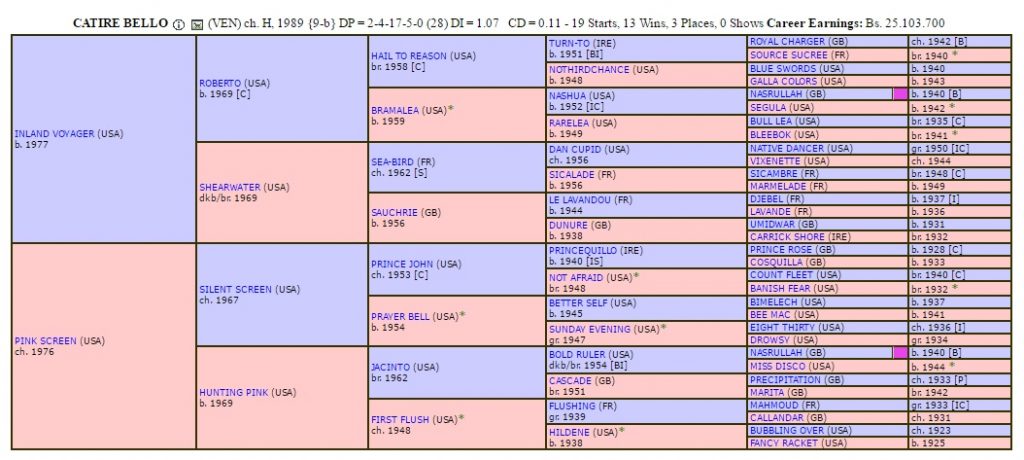
Catire Bello and Douglas Valiente return to the winner’s circle, flanked by owner Oswaldo Bello, left, and trainer Ivan Calixto, right (photo by Hipodromo Digital).
Quick, who was the last winner of a Triple Crown to race in the Florida Derby?
If you guessed it was Affirmed in 1978, you guessed wrong.
The year was 1992, and that colt, who finished sixth in Hallandale, Florida, went on to win a Triple Crown — in his native Venezuela.
His name was Catire Bello, a chestnut colt by Inland Voyager (Roberto) out of Pink Screen, by Silent Screen. An attractive yearling at the sales ring, being a son of one of the most influential sires in Venezuela and coming from a proven dam, Catire Bello was purchased for approximately $40,000 by businessman Oswaldo Bello, who followed the advice of trainer Ivan Calixto, who liked the horse despite his smallish frame (he weighed approximately 900 lbs.)
From his debut, Catire Bello was impressive. He won his first start as a 2-year-old by daylight, in what was going to be his only non-stakes race, a maiden 5 ½-furlong contest at La Rinconada Hippodrome. With four wins (including two graded stakes) and one second in five races, Catire Bello was named Venezuelan Champion 2-year-old in 1991.
Expectations were high for the speedy sophomore in 1992 — and Catire Bello didn’t disappoint. He cruised to victory in his first two outings, confirming his champion status, but the way he was winning made his connections think of something bigger for him. It didn’t take long for them to make the crucial decision: sending Catire Bello to the United States to participate in the Florida Derby, with the ultimate goal being the Kentucky Derby.

(Graphic by pedigreequery.com.)
The small chestnut arrived at Gulfstream Park two weeks before the Florida Derby, having to spend seven days in quarantine, an obvious disadvantage to add to the fact that he was going to face stronger competition, and that he hadn’t raced beyond a one-turn mile. He got plenty of attention from the media. Many remembered the fairy tale story of Canonero II, the 1971 Kentucky Derby winner and Eclipse Award champion from Caracas, Venezuela. The original plan for Catire Bello included the Gotham Stakes at Aqueduct if things went well at Gulfstream, or the Tropical Park Derby at Calder as an alternative prep. Both Calixto and Bello were also willing to consider offers for their stellar colt.
Unfortunately, the Florida Derby dream turned into a nightmare. With hundreds of Venezuelan fans, two radio crews and one Venezuelan TV crew in attendance, Catire Bello lost all chance to win from the start, as he hit the gate coming out, suffering a considerable cut on his left stifle.
Douglas Valiente, a former Gulsftream Park top jockey and Catire Bello’s regular rider, didn’t panic. Instead of forcing his mount to the lead, he decided to seek a stalking trip. The horse improved position on the far turn and, for a moment, it seemed like he might be a factor, but Valiente had to steady him at the 3/16ths pole and the gallant colt finished sixth, crossing the wire eight lengths behind Technology. All things considered, Catire Bello’s race was anything but disappointing, so he was given not one, but two more chances in the USA.
The Tropical Park Derby, at nine furlongs, was a terrible race for Catire Bello. He broke better this time, but faded in the backstretch, finishing a dismal ninth. After the race it was discovered that the colt raced on a higher-than-usual level of Lasix and that probably was the reason for such a dull effort.
With valid excuses for each of his two outings, Catire Bello was then sent to Churchill Downs and ran in the Derby Trial Stakes over a mile. This was the only race in which Doug Valiente didn’t ride him. With veteran jockey Earlie Fires aboard, the Venezuelan champ came from off the pace to finish fourth, several lengths behind Alydeed, who won with ease. The goal of being in the starting gate for the Most Exciting Two Minutes in Sports became unreachable and Catire Bello was returned to Venezuela, where history was to be made.
Back at La Rinconada Racetrack in Caracas, Catire Bello looked somehow diminished. As a result of travelling from Venezuela to Florida, then to Kentucky, and then back to Venezuela via Miami, plus three demanding efforts in five weeks, the champion colt had lost more than 30 lbs. Still, Calixto and owner Bello agreed upon entering Catire Bello in the Grade 1 Clasico Jose Antonio Paez, the first leg of the Venezuelan Triple Crown, at one mile — a decision that was widely criticized.
Almost everyone was skeptical about asking the colt to race only a month after his return. Calixto prepared him with only easy, two-mile gallops, trying to save the best for the Paez. The cynicsm lured ten rivals to the race, because Catire Bello was considered vulnerable.
The champion was back to prove his superiority. Breaking from the outside post, and racing wide throughout, Catire Bello stalked the early speed; then, Valiente made a bold move at the 3/8ths, and he defeated his foes in a very respectable 1:37 2/5, four lengths in front. He was the best in Venezuela, and no one doubted it.
The criticism stopped… not so the skepticism.
Could Catire Bello respond over a mile and a quarter with only three weeks rest? Eleven 3-year-olds were entered in the mile and a quarter, Grade 1 Clasico Ministerio de Agricultura y Cria, the second leg of the Venezuelan Triple Crown. Although Catire Bello had put back some of the lost weight, there were doubts about his ability to go beyond a mile.
Valiente and Calixto were confident the week of the race. The chestnut was given longer gallops in order to provide more stamina. Catire Bello rocketed out of gate 11, Valiente guided him to the inside and he took an early three-length lead. On the far turn, Catire Bello was asked to pick up the pace and he effortlessly took off. He was at least ten lengths in front turning for home and ended up trouncing his weak rivals by 22 lengths to the roar of the almost 20,000 fans who gather at La Rinconada.
Skepticism? Not anymore. Catire Bello was poised to become the fourth Triple Crown winner in Venezuelan racing history.
The third leg of the Triple Crown was the mile and a half, Grade 1 Clasico Republica de Venezuela (a.k.a. Venezuelan Derby). This time it was a five horse field. With five weeks rest, Catire Bello was back to his usual self. He looked perfect in the mornings, and no one predicted a loss. With absolutely no means of comparison, this race had some similarity to the 1973 Belmont Stakes. The favorite was challenged from the start and forced to set an almost suicidal pace.
When the first quarter was clicked off in :21 2/5, almost everyone present gasped. Many thought that Camici, a natural sprinter, was sent with the only intention of ruining Catire Bello’s Triple Crown chances. Douglas Valiente knew that he had the best horse, so he just put away the inferior Camici and then worked on relaxing his mount. The champ continued at a demanding pace — 1:10 for six furlongs, 1:36 3/5 for a mile — but, even so, no one came even close to Catire Bello, who strolled home with ease, Valiente responding to the cheers of the crowd while crossing the wire nine lengths in front.
He became the fourth Venezuelan Triple Crown winner since its inception in 1960.
Later in 1992, Catire Bello won the Grade 1 Clasico Copa de Oro (Venezuelan Gold Cup) against older horses, but came in second in the Grade 1 Clasico Simon Bolivar, the most important race in Venezuela. He was the favorite to win the Caribbean Derby at the old El Comandante Racetrack in Puerto Rico, but couldn’t beat Leonardo, the Panamanian Triple Crown winner, ridden by Cornelio Velasquez.
After only one race at the age of four, which he won, he was forced to retire due to an injury in his right foreleg. Catire Bello produced some stakes winners and was the leading first crop sire in 1997 and leading Venezuelan bred sire of 1999. He died on Feb. 20, 2001, victim of laminitis.
Catire Bello is considered one of the best Venezuelan horses of all time — a remarkable runner and a fierce warrior.



